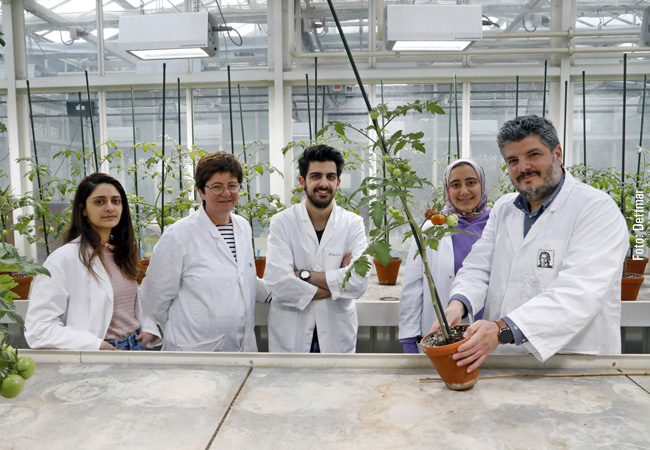Molecular biologist Sotirios Fragkostefanakis researches epigenetic procedures to develop food plants.

Agriculture has benefited greatly from the science of genetics, which can help create varieties with much higher yields: Plants with useful properties are selected, and then crossed with others exhibiting different desirable characteristics. The result is hybrid types that are more resistant to pests and diseases, for example, and better at adapting to different environmental conditions. But even cultivated varieties with the best growth and yields can no longer withstand the major challenges faced by contemporary agriculture: While climate change, water shortages and poor soil quality all restrict agricultural yields, the global population continues to grow and, with it, demand for food. Employing epigenetic procedures – i.e. those used specifically to switch individual genes on and off – alongside genetic ones in the development of food crops can lead to significant advancements in food production. Molecular biologist Dr. Sotirios Fragkostefanakis has been researching this method at Goethe University for several years.
UniReport: What exactly does the field of “epigenetics” explore – and how is it different from conventional genetics?
Sotirios Fragkostefanakis: In genetics, all organisms are described by the order of the four bases A, C, G and T in their DNA. Any changes to this genetic code result in the organism synthesizing different proteins. As a result, some of the organism’s characteristics are either lost or develop differently. In epigenetics, by contrast, gene activity is controlled without changing the genetic code.
What happens to the DNA for a gene to be controlled epigenetically?
A vital role is played by methyl groups, i.e. relatively small chemical groups that consist of one carbon atom and three hydrogen atoms. In the presence of certain enzymes, they attached themselves to a DNA molecule. It should be mentioned here that it can make a huge difference where exactly on the DNA molecule this methylation takes place. The decisive factor, however, always is the number of methyl groups attached to a DNA molecule. If many methyl groups are present – a state called hypermethylation – a gene’s activity will be hindered or even blocked. If, on the other hand, there is a shortage of methyl groups, we speak of hypomethylation – a state where gene expression is enhanced, and in which a gene that is normally in the resting state can even be switched on.
Where in nature can one observe epigenetic regulation of gene activity?
One example is the mechanism of vernalization: some plant species such as winter cereals have to be exposed to a prolonged period of cold before they can flower and reproduce. This ensures that the plants don’t start flowering until the spring, and protects the delicate flowers from being destroyed. It has been shown in Arabidopsis thaliana that during vernalization, methyl groups are removed from the section of DNA that contains the FLOWERING LOCUS C (FLC) gene. This activates the FLC gene, and Arabidopsis thaliana begins to produce flowers.
Another example can be observed when potatoes or tomatoes are fighting off the oomycete Phytophthora infestans, the pathogen that causes the devastating disease known as “late blight”: in such cases, the resistance gene R3a generally is inactive. It is only activated when methyl groups are removed from that particular section of the plant’s DNA, and then produces a protein that protects the plant against Phytophthora infestans.
How can progress in epigenetics help increase crop yields?
Epigenetics is considered to be one of the most important tools for improving the yields of the plant varieties currently available. If we employ genetics to achieve this, that is, if we want to alter a plant’s DNA, we can either use traditional breeding techniques – which take a very long time – or we create transgenic plants, which isn’t allowed in Europe. It’s much faster, simpler and safer if we don’t manipulate a plant’s DNA and instead influence specific gene expression using epigenetic techniques.
What are the implications on agriculture if crops are developed using epigenetic mechanisms?
On the one hand, crop yields will be higher because the epigenetic changes will make each individual plant considerably more productive. On the other, farmers will need much less input to reap good harvests. Requiring less fertilizer and pesticides will make it easier for them to produce organic food and still manage difficult conditions, for example poor soil or extreme weather events such as heatwaves, droughts or floods.
What questions in epigenetics are you tackling right now?
My work group is interested in how the activity of plant genes is regulated at high temperatures, how plants respond to heat stress, and with what mechanisms they protect themselves against heat. To give just one example: In 2020 we showed how this thermotolerance developed during the domestication of tomatoes. We are currently collaborating with Israeli researcher Michal Lieberman-Lazarovich, and investigating how thermotolerance depends on the methylation of plant DNA.
What are the challenges facing research in epigenetics?
Researchers currently face four main challenges. The first concerns the stability of epigenetic modifications. If a plant characteristic based on an epigenetic alteration is to be passed on to succeeding generations, it first has to remain stable over a major part of an individual plant’s lifecycle. Of course it then must also in principle be inheritable, and the probability that epigenetic modifications are passed on to the offspring is generally lower than in the case of genetic modifications, i.e. changes to the DNA sequence.
In addition, epigenetic modifications are extremely complicated and can be influenced by many factors; the complexity of epigenetic interactions presents quite a challenge. And finally, the point of epigenetic modification is to alter the parts of an organism’s DNA that control the activity of a certain gene. So creating an epigenetically modified plant means creating a plant with modified DNA. However, by definition this is then a transgenic plant – whose creation and use are subject to many major legal restrictions.
How is epigenetics research supported on a political level?
The EU funding organization COST (European Cooperation in Science and Technology) provides support over a four-year period for the exchange of knowledge within interdisciplinary research networks called COST Actions. One of them is the EPI-CATCH platform (EPIgenetic mechanisms of Crop Adaptation To Climate cHange), funded since September 2020, and which comprises 43 departments – including my group at Goethe University – from 22 European countries. In our case, “interdisciplinary” means that researchers from many different life sciences collaborate within the EPI-CATCH framework – they represent not only molecular biology, but also genetics, epigenetics, plant physiology and biochemistry. Since the experiments run by all these scientists generate huge amounts of data, we naturally also have bioinformaticians working on this interdisciplinary EPI-CATCH project.
What are the risks associated with epigenetics?
One method for triggering epigenetic changes in a plant is to expose it to environmental stresses such as heat, cold or drought. Another method for modifying the methylation of a certain section of DNA – in other words, making epigenetic changes in this section – is to use suitable chemicals. These chemicals can pose a risk to both humans and the environment. While this may not yet play such an important role because epigenetics is still at the stage of basic research, as soon as the method yields applications with an economic benefit, we will have to ensure that the use of chemicals that induce epigenetic modifications remains safe both for the environment and for consumers.
Questions by Stefanie Hense













